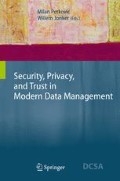Abstract
This chapter discusses two important concepts in digital rights management (DRM). The first concept is authorized domains, which bind content to a domain allowing, content to be accessible on a set of devices. The second concept is person-based DRM, which binds content to a person and makes it available after authentication. Special focus is given to the combination of these concepts, which we call the personal entertainment domain (PED). We discuss the advantages and present the architecture of this concept.
Access this chapter
Tax calculation will be finalised at checkout
Purchases are for personal use only
Preview
Unable to display preview. Download preview PDF.
References
R. Vevers, C. Hibbert: Copy Protection and Content Management in the DVB. In: IBC Conference Publication, Amsterdam, IBC2002, 15-9-2002. pp. 458–466
S.A.F.A. van den Heuvel, W. Jonker, F.L.A.J. Kamperman, P.J. Lenoir: Secure Content Management in Authorised Domains. In: IBC Conference Publication, Amsterdam, IBC2002, 15-9-2002. pp. 467–474
Open Mobile Alliance: DRM Architecture: Approved Version 2.0, 3-3-2006.
Open Mobile Alliance: DRM Specification: Approved Version 2.0, 3-3-2006.
Apple: iTunes Music Store: Authorizing your computer. http://www.apple.com/support/itunes/musicstore/authorization. Cited 2005.
Wikipedia: FairPlay. http://en.wikipedia.org/wiki/FairPlay. Cited: 21-3-2006
F. Pestoni, J.B. Lotspiech, S. Nusser: xCP: peer-to-peer content protection. IEEE Signal Processing Magazine. 21(2): 71–81 (Mar 2004)
Thomson: SmartRight: Technical white paper, version 1.7, January 2003.
B. Rosenblatt, B. Trippe, S. Mooney: Digital Rights Management: Business and Technology (M&T Books, New York 2002)
S. Wegner (ed.): OPERA-Interoperability of Digital Rights Management (DRM ) Technologies: An Open DRM Architecture, Eurescom, 2003.
Secure Digital Music Initiative: SDMI Portable Device Specification: Part 1, Version 1.0, 8-7-1999
Microsoft: Windows Media Digital Rights Management. http://www.microsoft.com/windows/windowsmedia/drm/default.aspx. Cited 2005.
Microsoft: Next Generation Windows Media DRM for Consumer Electronics Devices. In: WinHEC2004, 2004.
Microsoft: Windows Media Connect-Connectivity Solution for Networked Media Players. In: WinHEC2004, 2004.
Iannella, R.: Open Digital Rights Language (ODRL) Version 1.1, 2003.
C. Conrado, M. Petkovic, W. Jonker: Privacy-Preserving DRM, In: Secure Data Management, 2004. Lecture Notes in Computer Science, vol 3178 (Springer, Berlin Heidelberg New York 2004)
R.P. Koster, F.L.A.J. Kamperman, P.J. Lenoir, K.H.J. Vrielink: Identity based DRM: Personal Entertainment Domain. In: Communications and Multimedia Security, Salzburg, Austria, September 19–21 2005. Lecture Notes in Computer Science, vol. 3677 (Springer, Berlin Heidelberg New York, 2005) pp. 42–54
S. Guth: A Sample DRM System. In: Digital Rights Management: Technological, Economic, Legal and Political Aspects. Lecture Notes in Computer Science, vol. 2770 (Springer, Berlin Heidelberg New York 2003)
B.C. Popescu, B. Crispo, F.L.A.J. Kamperman, A.S. Tanenbaum: A DRM Security Architecture for Home Networks. In: ACM Workshop on Digital Rights Management, 2004.
Q. Liu, R. Safavi-Naini, N.P. Sheppard: Maintaining Count Constraints in a Household Domain in DRM. In: IEEE International Workshop on Software Support for Portable Storage, 2005.
S. Brands: Rethinking Public Key Infrastructures and Digital Certificates; Building in Privacy (MIT Press, August 2000)
Liberty Alliance Project: Liberty ID-FF Architecture Overview, version 1.2, 2005.
Author information
Authors and Affiliations
Editor information
Editors and Affiliations
Rights and permissions
Copyright information
© 2007 Springer-Verlag Berlin Heidelberg
About this chapter
Cite this chapter
Koster, P. (2007). Person-Based and Domain-Based Digital Rights Management. In: Petković, M., Jonker, W. (eds) Security, Privacy, and Trust in Modern Data Management. Data-Centric Systems and Applications. Springer, Berlin, Heidelberg. https://doi.org/10.1007/978-3-540-69861-6_20
Download citation
DOI: https://doi.org/10.1007/978-3-540-69861-6_20
Publisher Name: Springer, Berlin, Heidelberg
Print ISBN: 978-3-540-69860-9
Online ISBN: 978-3-540-69861-6
eBook Packages: Computer ScienceComputer Science (R0)

